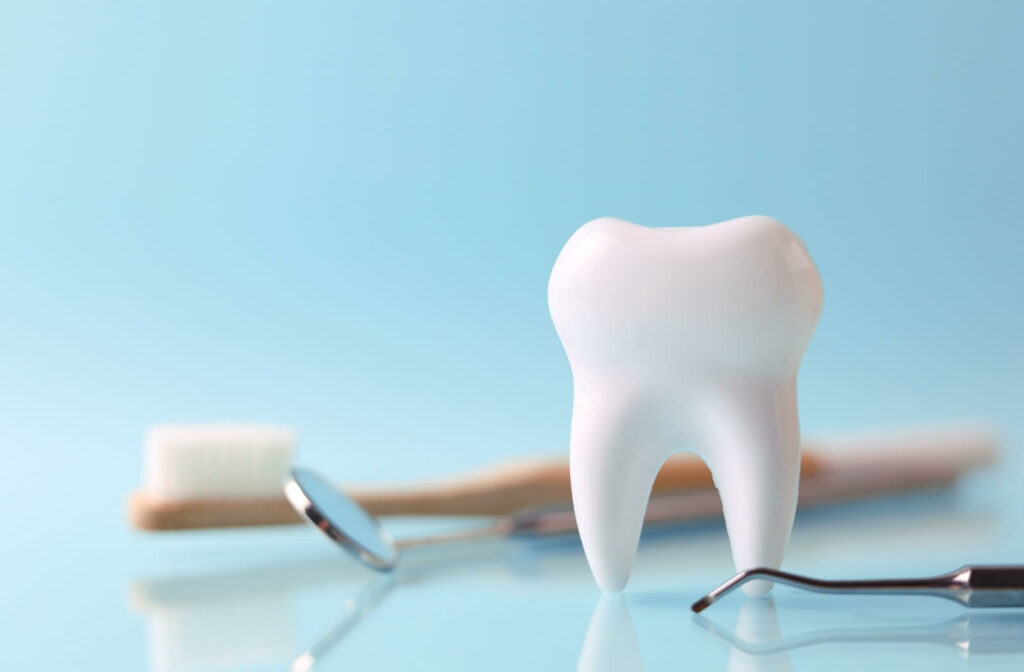A tooth extraction is a common type of restorative dental care, but it’s natural to wonder what comes next. Knowing how to care for your mouth afterward can help you feel more comfortable and support a smooth recovery.
After a tooth is removed, your body begins a natural healing process that starts with forming a protective blood clot, followed by new tissue growth over several days and weeks. Your main role is to follow simple aftercare instructions to protect the area. With a little care, and by making sure to eat right afterwards, you can be back to your routine in no time.
The First 24 Hours: Your Immediate Care Plan
The first day after your tooth extraction should be focused on rest and on allowing the healing process to begin. Your main job is to protect the blood clot that forms in the empty socket. This clot is the foundation for new tissue to grow.
Rest & Recovery
Plan to take it easy for the rest of the day. Limit exercise and strenuous activities that could increase blood flow to the head. When you rest, try to keep your head propped up with an extra pillow to help reduce bleeding.
How to Manage Bleeding
Some minor bleeding or oozing is normal. If you notice persistent bleeding, bite down firmly on a clean piece of gauze placed directly over the socket for at least 15 minutes. It’s important to avoid rinsing your mouth, as this can disturb the important clot.
What You Can Eat & Drink
Stick to soft foods and liquids to avoid putting pressure on the extraction site. Good options include yogurt, applesauce, eggs, and pasta. Do not use a straw for at least 24 hours, as suction can dislodge the blood clot.
Your Heal Timeline: What to Expect Day by Day
Healing happens in stages. It starts with the blood clot, followed by new tissue growth over several weeks. While everyone heals differently, you can expect a general progression.
The First Few Days
You’ll likely feel more like yourself within a few days and can return to most routine activities after 48 to 72 hours. It’s common for discomfort and swelling to peak around day two or three. You may still feel some effects from the dental freezing during the initial hours, but after that, any discomfort should start to get better.
Long-Term Jawbone Heal
While your gums will heal much faster, it takes several weeks for the jawbone to fully fill in the empty socket. This process of alveolar bone regeneration is a natural part of healing. For a large tooth like a molar, this could take a few months. Patience is key as your body does its work.

Aftercare Dos & Don’ts for a Smooth Recovery
Follow these simple guidelines to support the healing process and stay comfortable.
Things You Should Do
- Eat soft foods that are easy to chew.
- Gently rinse the area with a saltwater mouthwash after 24 hours.
- Take any prescribed medications exactly as directed.
- Continue to brush & floss your other teeth carefully.
Things You Should Avoid
- Any strenuous activity that raises your heart rate.
- Poke at the extraction site with your tongue or fingers.
- Smoke or use vape products, as tobacco use can lead to oral health complications.
- Spit forcefully or rinse your mouth too vigorously.
Spot Potential Problems & When to Call a Dentist
While complications are not common, it’s good to know what to look for. If you have any concerns, it’s always best to contact your dental office. As always, we’re here to help guide you through your recovery.
What Is a Dry Socket?
A dry socket occurs if the protective blood clot is dislodged before the socket has healed. This can cause significant discomfort because it exposes the underlying bone and nerves. Following your aftercare instructions is the best way to prevent this and avoid common dental emergencies.
Signs of an Infection
Contact your dentist in Hamilton if you experience any of these signs. These symptoms may indicate that the site is not healing as it should be. Prompt attention can help you get back on track.
- Fever
- Pain that gets worse instead of better after a few days
- Pus or foul-smelling drainage from the socket
- Swelling that continues to increase after 3 days
Look Ahead: Your Tooth Replacement Options
Once your mouth has healed, you may want to discuss how to replace the missing tooth. A replacement can help with chewing function and prevent nearby teeth from shifting out of place. This is an important step in maintaining your overall oral health.
Why Replace a Missing Tooth
A gap in your smile can affect your bite and the alignment of your other teeth over time. Deciding whether you can replace a missing tooth is important, as filling the space helps maintain the structure and health of your mouth. It also restores your smile and makes eating more comfortable.
Your Treatment Choices
There are several ways to replace a missing tooth—partial dentures, bridges, and implants are common treatment options. Your dentist can help you decide which path is right for you. Your options may include:
- Dental Implants: A titanium post that acts as a new root for a replacement tooth.
- Dental Bridges: A false tooth that is anchored to the teeth on either side of the gap.
- Partial Dentures: A removable appliance that fills the space left by one or more missing teeth.
For some procedures, your dentist may suggest a referral to a specialist to help you achieve your desired results.
At Upper Gage Dental Centre, our team is here to support you through every step of your dental journey. If you have questions about tooth extractions or your replacement options, please reach out. We look forward to helping you achieve your oral health goals.



